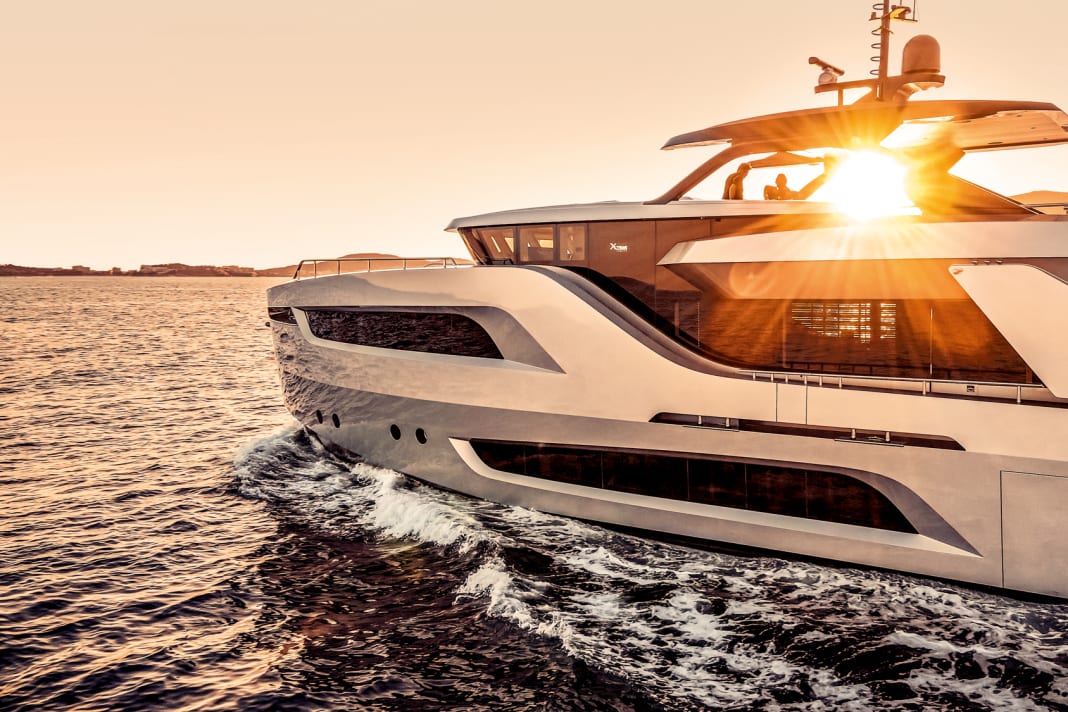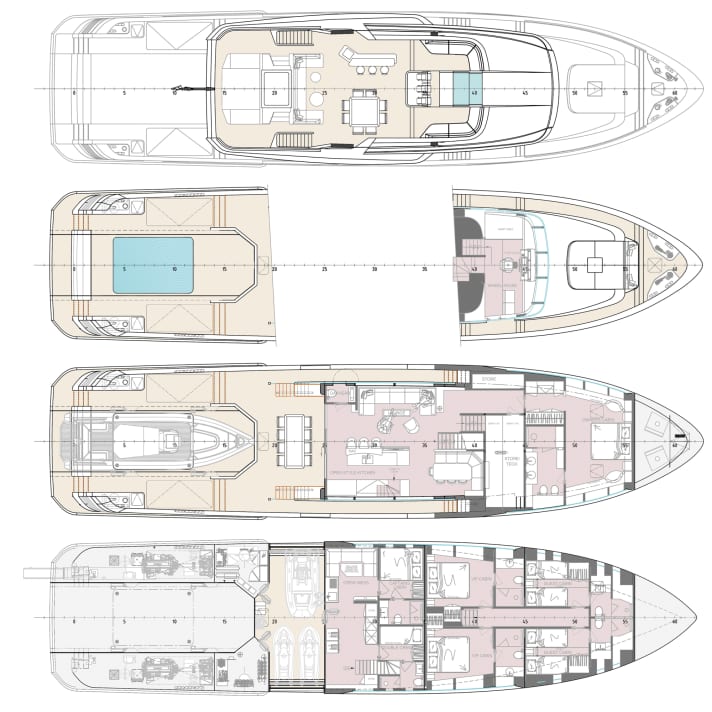





The stern water foams as if "Lady Fleur" were docking. The 33 metres are firmly moored and the propellers are at rest. Nevertheless, clusters of people form with mobile phone cameras at the ready. What makes the X-treme 105 a showstopper during the Cannes trade fair is its tender lift. The Dutch company manages the streams of visitors extremely skilfully by regularly sending the tubular, ten-metre-long and eleven-tonne platform into the water. The two-minute operation displaces plenty of water and raises the steel structure aft by several centimetres. Shipyard manager Robbert Holterman operates the lowering and lifting mechanism and, after the procedure, invites the crew on board to cool their feet in the pool, which is otherwise covered by an eleven-metre-long tender that now nestles against the port flank.
"At Holterman Yachts, owners with innovative ideas are always welcome, but it's fair to say that we went far beyond the norm with this project." The owners did not want to tow their chase boat through the Mediterranean on a line as before, but instead wanted to store the eleven-metre RIB on deck - and launch it without a crane: "We wanted to be able to sail quickly to destinations on land and in shallow bays, while at the same time allowing our adult children to go water skiing and wakeboarding." In addition, a telescopic crane pulls a RIB, two jet skis and toys out of the side parking bay.
The chaseboat of the"Lady Fleur" sails on the aft deck with
Deploying the large tender was the real complexity. Due to the draught of the Skipper 38 with Z-drive (!), the platform had to be lowered one metre below the water surface to allow it to float freely. What followed was a masterpiece of mechanical engineering by the shipyard and Diana Yacht Design. After weeks of tests and simulations, the vertical lowering as in a hydraulic lift was abandoned. The four corners would have had to move exactly synchronised, otherwise there would have been a high risk of overshooting due to jerking. Instead, it had to be a continuous swinging movement similar to a pantograph door.
The Diana engineers designed four rotor arms, each with three points, which can lift a total of around 30 tonnes 2.50 metres high: The first joint is connected to the inside of the fuselage, with the hydraulic cylinder just behind it and the platform at the very aft end of the rotor arm. "An idea like this has never been tried before, so we were in constant dialogue with the classification society and the flag state," says the design office.
We also had to fulfil a seemingly contradictory usage request. We wanted to park an eleven-metre tender on the deck and at the same time have a saltwater pool for the grandchildren. As soon as the tender is lowered into the water, a five-metre-long recess within the platform fills with up to 14 tonnes of seawater, creating a bathing depth of 1.50 metres, which can be infinitely adjusted to the "pied dans l'eau" dimension of 30 centimetres. The "Lady Fleur" clients make it clear: "After spending time on fast boats, we wanted to spend many more years on the water with our children and grandchildren. One of the things we wanted was a pool for the little ones too."
The rear section combines the interests of three generations
Another design challenge awaited in the form of the side hulls. Basically, the stern is constructed like a catamaran, but its hull ends are not held together by cross-connections. Instead, the floats have to bear the weight of motors, shafts, generators or water makers. Numerous finite element calculations ensured that the stern does not work too hard or vibrate when the drive is running. Holterman welded the two steel stays to the stern frame using 60 millimetre thick inserts to prevent fatigue or cracks. Above deck, the hull merges into a high bulwark, a requirement for the safety of the very young.
The exterior of X-treme's debut model was designed by Bernd Weel, also from the Netherlands and now the in-house designer of the new Holterman brand. It sets itself apart from the previously built compact steel displacement vehicles with a more modern design language. The flagship "Lady Fleur" bears the model name X-treme 105 and Weel's signature, inspired by superyachts such as the 92-metre "Queen Miri": "There are features that you don't normally find on a 33-metre ship. This enormous challenge created a very strong energy among everyone involved in the project. We tried to make the impossible possible."
The trained architect and car designer developed the layout with eight berths below deck and two in the master suite in the bow together with the shipyard and the owners. His inspiration for the exterior: "We were inspired by nature and attacking predators to create a design that looks muscular and powerful and is ready to tackle any sea. There are the muscular shoulders and the forward-sloping but low wheelhouse - it literally wants to move forwards."
The engines of the "Lady Fleur" sit in the catamaran hulls
Although the lines exude great propulsion power, the two main engines only produce 551 kilowatts each. Holterman also went its own way when it came to the engine, opting for commercial engines from Volvo Penta, which were optimised with the Swedes for use on a superyacht. "Lady Fleur" moves at a maximum speed of 15 knots and efficiently and comfortably at ten knots. The latter speed opens up a range of 2400 nautical miles with full bunkers. The development team made a virtue out of the necessity of not being able to place the drive amidships and arranged the engines in the outposts of the hulls. There, hydraulic hatches provide immediate access and the option of uncomplicated removal.
The propeller and motor unit is positioned far to the rear, so the shaft runs horizontally, which increases efficiency and reduces vibrations. Nevertheless, Diana carried out many CFD tests due to the lateral positioning so that the propeller would not suck in any air. The designers' solution: "Nozzles around the propellers help to direct the water flow. This took many weeks of fine-tuning, but had the added benefit of allowing the nozzles to act like a rudder. This proved to be very efficient and even generated some lift, which reduces drag and therefore fuel consumption."
Salon inspired by country life
Consumption economy is also the basis of the on-board power supply architecture. The two Cummins generators do not feed the consumers directly, but pass their energy on to a lithium-ion bank, which always provides the exact amount of power required. It was important to the owners to be able to go on long voyages with little or no crew and not have to think about repairs: "We wanted to ensure that technical defects would not affect valuable family time. No matter how well the equipment is designed and installed, it will fail in rough seas and at the most inopportune moments. The answer was a very high level of redundancy: from bow and stern thrusters to battery chargers and inverters, we have two of everything that could fail and interrupt our fun." Two pairs of fin stabilisers were even ordered from CMC in Italy. They move electrically, as the hydraulic version would have taken up too much hull space.
Trimm Design from Leeuwarden was responsible for decorating the almost 200 gross tonnes of interior space, which was to be "airy" and "not yacht-like". The saloon was modelled on living rooms on land. Here, easy-care PVC flooring in a herringbone pattern and a robust carpet in front of the XXL sofa speak for family-friendliness. A galley was important to the owners: "We moved away from the usual layout on 100-foot yachts and placed the galley directly to starboard of the entrance. The open kitchen forms a social centre and provides excellent access to the outside dining table." Forward, a cosy dinette to starboard beckons, next to it the companionway to the guest rooms and the stairs up to the bridge. Outside, a spacious hallway leads to the owner's suite, where taupe-coloured panels alternate with snakeskin and matt walnut wood. The bathroom features black fittings and a spaciousness that is unusual for yachts.
The aft deck becomes a ten metre long and 7.50 metre wide party base when tender number one is hanging on the line and the pool is covered. Parties after dinner are enjoyed by all three generations. Just the way the owners like it.
Technical data
- Length over everything:32,65 m
- Width:7,84 m
- Depth:1,85 m
- Gross tonnage:198 Gross Tons
- Material:Steel-aluminium
- Motors:2 x Volvo Penta D16 MH
- Engine power:2 x 550 kW
- Speed (max.):15 kn
- Speed (travelling):10 kn
- Range @10 kn:2400 nm
- Generators: 2 x Cummins Onan
- Fuel:19.000 l
- Water:2100 l
- Stabilisers:4 x CMC Marine
- Stern thruster:2 x 15 kW
- Bow thruster:2 x 15 kW
- Construction:Diana Yacht Design
- Exterior design:Bernd Weel Design
- Interior design:Trim Design
- Class:REG LYC Part A
- Shipyard:Holterman Shipyard, 2022

Also interesting:
- "Go": 77 metre long eye-catcher with extravagant hull colour
- "El Leon": Power package for speed-hungry owners
- Launch news: Columbus Yachts launches 50-metre yacht designed by Marco Casali

